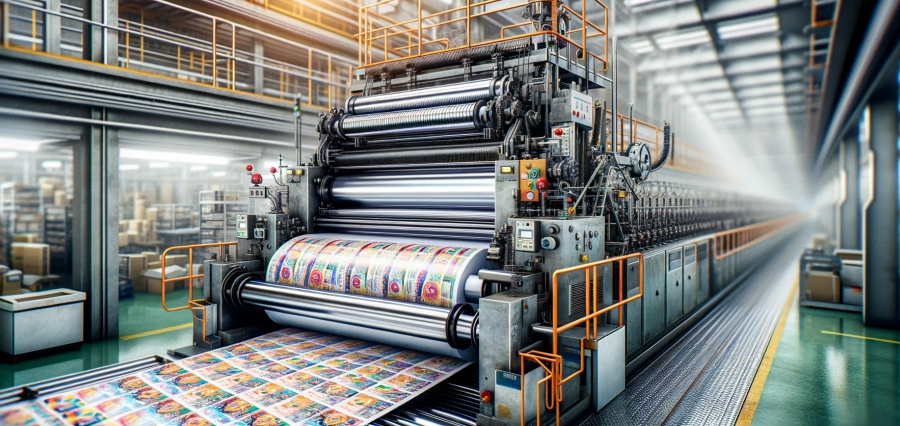Although the modern printing industry has several printing techniques for applying images and logos to different kinds of surfaces, flexography stands as the most popular one. Today, flexography is the leading printing method for the manufacturing of product packaging.
Below, we’re going to discover what such wide popularity is explained by and mention the key advantages of flexography.
Back in History: Flexography Milestones
The technology passed numerous transformations and improvements until it reached the modern manufacturing industry. The method was introduced in the 1890s and became innovative in the industry of those years. While existing methods used fixed rigid plates, flexography allowed making the plate more flexible, which is why it deserved its name “flex” (flexible).
Another transformation caused by this improvement was shifting the direction of the printing procedure. While existing methods used the scheme where machines with plates moved to printing surfaces, flexography turned this concept, keeping a printing machine standstill and requiring a printing material (paper or whatever) to move on top of the plate. This innovation allowed simplifying and speeding up the printing process.
The technique allowed manufacturers to expand the range of surfaces for printing. The method could be applied to cellophane, plastics, metal films, etc. The rise of the 1920s was remarkable for flexography since the industry recognized the technique as the best solution for applying marketing information to food packaging.
Today’s Flexo Industry: Features & Updates
Nowadays, flexographic printing is still the most popular and high-quality option for creating durable and safe wrappers for products. The following improvements have been recently integrated:
photopolymer printing plates;
laser-etched ceramic anilox rolls;
digital direct-to-plate” systems.
These updates brought the technology to a higher level, allowing manufacturers to print full-color pictures on different surfaces.
Advantages of Flexo Technology for Food Packaging
Now, let’s outline the main pros and cons of flexographic printing for applying logos and other marketing information on wrappers.
The method is compatible with diverse inks. Constant improvements in the tech processes allowed manufacturers to apply any ink. These days, the following classes of inks are used in the industry:
water-based;
solvent-based;
ultraviolet curing;
electron beam curing;
two-part chemically curing.
A wide spectrum of applied ink helps make covers more durable, attractive, and functional. In addition, inks dry fast, which allows for saving time and materials.
Perfect compatibility with different types of surfaces. The method can be applicable to both non-porous and porous surfaces, making the technology suitable for any production and commercial needs. Flexography guarantees an excellent result on plastic wrappers, paper, cardboard, cellophane, metalized films, etc. It is also used to apply inks to wallpaper.
Faster production speed. When evaluating the benefit of the technology at an industrial scale, the faster you proceed, the less costs your business has. Thus, deployment time affects company profit. Flexo machines are assembled and set up quicker than other equipment, meaning that you need less time to start producing wrappers.
The ability to integrate extra tools and devices to add new capacities and functions. Flexo machines provide users with the ability to integrate die-cutting, laminating, and other finishing stations to achieve additional effects and improve wrapper durability.
The technology is cost-effective and affordable. When assessing the number of produced pieces of covers over a certain period of time, you’ll conclude that the ROI is quite high and the cost of machines is justified. The volume of produced products covers all the expenses of the manufacturing process (electricity, human labor, etc.). Besides, the plate relief is wear-resistant, meaning that users won’t have to change it after every run.
Deep rich coloring. If you want to have a saturated rich color image, flexography is the best solution. If compared to other techniques that require applying inks for several layers, flexo technology achieves the perfect deep-coloring image from the first application. This saves inks, resources, and time, while the resulting image is highly durable and eye-catching.
A sustainable solution. Although any printing technology implies the use of harsh chemicals, such as solvents or cleaning materials, this technique is considered a more sustainable option in comparison with other printing methods.
Excellent application images of any level of complexity. The method allows for printing multi-colored logos, pictures, labels, etc. The quality is perfect for both mono-color and multicolored images.
Such plenty of advantages of flexographic printing determine their wide distribution and popularity in the packaging industry. Most manufacturers stick to using this technology for the production of wrappers for their products.
Shortcomings of Flexible Printing Technology
Everything has a reverse coin in our world. There is nothing 100% positive. Thus, although flexography is very beneficial, experts still point out some drawbacks. These are:
Equipment complicacy. Parts and systems are quite complicated for installation, assembly, and maintenance. Thus, to eliminate the risk of severe problems, make sure to maintain machines regularly and assemble them in strict order with manuals.
Cost-ineffective for small runs or minor jobs. The technology is mainly applicable for big runs, where it’s necessary to print thousands of copies, while small runs may incur extra expenses.
Additional system integration may take more time to set up. If you need to add a new set of devices to apply new finishing solutions, you need time to find the right place and mechanism to install it.
However, regardless of these shortcomings, flexography has a high reputation. The mentioned drawbacks are minor if comparing them to the advantages. Thus, producers do not take them seriously. The main thing is to approach the setup stage attentively and spend enough time to guarantee proper assembly.
After all, flexo printing is used to produce covers for all sorts of products. Food, appliances, liquids, and other goods are packed in wrappers with flexo logos. Taking into account the listed pros, you realize why most producers prefer this method.


